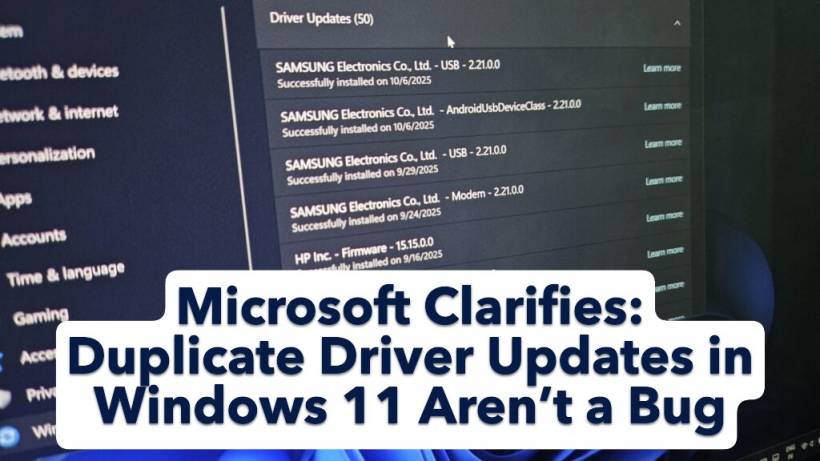If you've recently noticed duplicate driver updates in Windows 11 version 24H2 or 25H2, you're not alone — and according to Microsoft, it's not a problem. In a new support document released on October 22, the company confirmed that seeing duplicate or oddly labeled drivers in Windows Update is perfectly normal.
In fact, this behavior reflects Windows 11's improved ability to handle complex driver versioning and naming, rather than an underlying issue.
Understanding How Windows Drivers Work
Drivers are the unseen software components that allow Windows to communicate with hardware — from graphics cards and Wi-Fi adapters to touchpads and webcams. While Microsoft includes generic Windows drivers to ensure baseline functionality, the majority of drivers are developed and distributed by hardware manufacturers such as Intel, AMD, NVIDIA, Qualcomm, HP, and Lenovo.
These third-party companies push drivers through Windows Update, but Microsoft's strict validation process often means that the versions appearing in Windows Update lag behind the latest ones available on OEM websites.
For instance, users looking to access the newest Intel GPU features or optimizations are better off downloading directly from Intel's official site, rather than waiting for Windows Update to catch up.
Why Do Drivers Look Duplicated in Windows Update?
One of the most common user complaints revolves around confusing or repetitive driver names — such as seeing two HP drivers with identical names but different version numbers.
According to Microsoft, these duplicates are not errors. Windows 11 now includes enhanced logic that can differentiate between similar or duplicate-looking drivers. Even if two updates share the same name, class, or even version number, Windows is smart enough to detect which one is newer and more appropriate for installation.
This improvement comes from changes in how Windows 11 compares driver data. Instead of relying solely on version numbers, the operating system now compares the actual driver files, ensuring that only the most recent and compatible version is installed.
Custom Versioning and Naming: The Source of the Confusion
Driver providers often use their own custom versioning systems, which don't always follow a logical numerical order. This can result in cases where a "newer" driver looks older or where two versions appear identical.
Microsoft's support document explains that "Windows understands when to install these different drivers, even if the version numbers look older or duplicative."
Additionally, modern device designs sometimes split functionality across multiple drivers, leading to multiple related drivers being installed at once. This approach helps improve efficiency and modularity but can make updates appear redundant or overlapping to the end user.
File-Based Comparison: Smarter Driver Management in Windows 11
In the latest versions of Windows 11, the operating system now performs file-level comparisons when evaluating new driver updates. This means it examines the contents of the update rather than just its name or version number, ensuring that the system retains the most recent and compatible version automatically.
This enhancement particularly benefits users of Windows 11 24H2 and 25H2, as these versions are optimized to handle driver packages more intelligently — reducing confusion and the likelihood of installing outdated components.
What About Drivers from the 1990s?
It's not uncommon for users to encounter driver listings that appear to date back decades — sometimes even to the 1990s. While that might look alarming, Microsoft reassures that this, too, is normal.
The driver date displayed in Windows Update or Device Manager is simply metadata chosen by the driver provider and doesn't necessarily reflect its real release date or compatibility. Some vendors intentionally use older dates to ensure their drivers remain prioritized during version comparisons.
As Microsoft puts it, "Driver dates might look old, but that is not true. The driver date is descriptive info set by the driver provider and can be any date they choose."
The Bottom Line
Duplicate driver entries in Windows 11 aren't bugs — they're part of the system's smarter approach to managing complex hardware support.
With Windows 11 24H2 and 25H2, Microsoft has refined how the OS interprets driver metadata, version numbers, and file contents, ensuring users always end up with the most suitable driver, even when multiple appear identical.
So, if you spot duplicates, conflicting names, or "ancient" driver dates in your Windows Update list — don't panic. Windows 11 is simply doing the heavy lifting behind the scenes to ensure your system runs on the best possible configuration.




